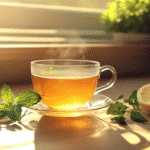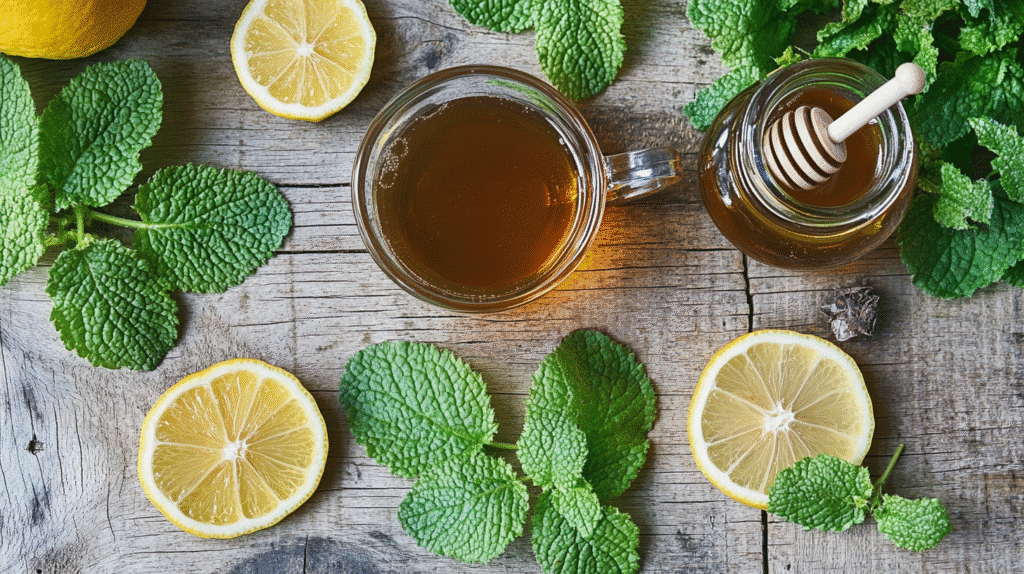Herbal teas have long been staples in traditional Korean remedies, and the korean lemon balm tea recipe is one of those treasured infusions that combines calm, citrusy flavor with healthful benefits.
In this article, you’ll discover how to make korean lemon balm tea recipe, learn its daily health potential, what to avoid mixing with it, and how much to use for the perfect cup.
Along the way, I’ll share my own connection to this soothing brew — from fridge raids to wellness rituals.
Plus, I’ll guide you through how to craft it in your own kitchen.
Table of Contents for korean lemon balm tea recipe

korean lemon balm tea recipe
- Total Time: 9 minutes
- Yield: 1 cup 1x
- Diet: Vegan
Description
A soothing Korean herbal tea using lemon balm leaves, perfect for relaxation and digestion.
Ingredients
1 tbsp dried lemon balm (or 3–4 fresh sprigs)
1½ cups boiling water
Optional: honey, lemon slice, fresh ginger
Instructions
Add lemon balm to teapot or mug.
Pour over boiling water.
Cover and steep 5–7 minutes (10 for stronger brew).
Strain and sweeten if desired.
Notes
Best enjoyed before bed or after meals.
Avoid combining with sedatives or thyroid medication.
- Prep Time: 2 minutes
- Cook Time: 7 minutes
- Category: Drinks
- Method: Steeped
- Cuisine: Korean
Nutrition
- Serving Size: 1 cup
- Calories: 5
- Sugar: 0g
- Sodium: 0mg
- Fat: 0g
- Saturated Fat: 0g
- Unsaturated Fat: 0g
- Trans Fat: 0g
- Carbohydrates: 1g
- Fiber: 0g
- Protein: 0g
- Cholesterol: 0mg
Why korean lemon balm tea recipe Deserves a Spot in Your Mug
My Fridge-Foraged First Sip
Let me tell you how I first stumbled into making korean lemon balm tea recipe.
It was one of those late nights when sleep just wouldn’t come.
I remembered a little zip-top bag in my pantry labeled “lemon balm” that I picked up from a local Korean market weeks earlier.
Desperate for calm, I brewed it. And wow—what started as a gamble turned into one of the most soothing cups I’ve ever had.
Since then, it’s been a staple when I need to unwind, soothe my digestion, or just want something gentle to sip.
As someone who grew up in a packed household and mastered the art of using what you’ve got, lemon balm tea fits right in.
It’s low-effort, low-cost, and you can make it fresh or dried.
Plus, the benefits go way beyond flavor—Korean lemon balm has a reputation for relaxing the nervous system, improving focus, and even easing mild menstrual discomfort.
It’s a solid herbal remedy to keep around.
Why It’s More Than Just “Another Herbal Tea”
Korean lemon balm (Melissa officinalis) is part of the mint family, but its scent leans citrusy rather than minty.
This makes it a refreshing option that’s great hot or iced.
Culturally, it’s been used in Korean traditional medicine for its gentle sedative effects, making it ideal for evening sipping or a midday reset.
And unlike caffeine-heavy teas or sugary bottled drinks, this one helps you feel relaxed without crashing later.
Not to mention, lemon balm tea plays nice with a variety of other healing ingredients. Just be careful what you pair it with—we’ll talk about that later.
But first, let’s get to the brewing!
How to Make korean lemon balm tea recipe the Right Way
Fresh vs. Dried Lemon Balm: What Works Best?
When it comes to brewing the perfect korean lemon balm tea recipe, you’ve got two solid options: fresh leaves or dried.
If you grow lemon balm yourself or grab a bundle from a Korean market, fresh is fantastic—it gives you a light, grassy citrus flavor that’s bright and clean.
But don’t worry if you only have dried leaves.
They’re just as effective and can even offer a slightly deeper, more herbal taste.
Here’s a quick comparison to help you choose:
| Type | Flavor | Prep Time |
|---|---|---|
| Fresh Leaves | Light, citrusy, grassy | Quick rinse, steep immediately |
| Dried Leaves | Stronger, earthy, slightly minty | Steep a bit longer |
You can even dry fresh lemon balm yourself: lay the leaves on a baking sheet in a dry, shaded spot for a few days, then store them in an airtight jar.
That way, you’ll always have a stash ready for cold days—or stressful ones.
Step-by-Step: Korean Lemon Balm Tea Recipe
Let’s keep it simple. This is the way I’ve been making it ever since that first late-night mug.
You’ll need:

- 1 tablespoon dried lemon balm leaves (or 3–4 fresh sprigs)
- 1 ½ cups boiling water
- Optional: a few slices of fresh ginger, raw honey, or lemon peel
Instructions:
- Place the lemon balm in a heatproof mug or teapot.
- Pour over the boiling water.
- Cover and let steep for 5–7 minutes. Longer if you’re using dried.
- Strain the leaves out.
- Sweeten with honey or add a citrus twist if you’d like.
That’s it. No fancy tools, no stress. Just warm, herbal comfort in a cup.
Daily Use of Lemon Balm Tea — How Much Is Just Right?
Can I Sip This Every Day? Yes, But…
Drinking korean lemon balm tea recipe daily can be a calming ritual—especially if you deal with stress, restlessness, or sleep issues.
Many people in Korea and beyond brew it nightly as part of a bedtime routine or after a heavy meal.
It’s naturally caffeine-free, gentle on digestion, and soothing for your nerves.
That said, like anything herbal, balance matters.
If you’re generally healthy, sipping 1 to 2 cups a day is perfectly fine and often beneficial. Some people notice better sleep, reduced bloating, or even a bit of mental clarity after a few weeks of regular use.
Studies suggest lemon balm may help regulate cortisol (the stress hormone), making it a great addition to your wind-down routine.
But daily use isn’t for everyone. If you have a thyroid issue—especially hypothyroidism—check with your doctor before going all in.
Lemon balm can slightly affect thyroid hormone uptake, so it’s better to be cautious.
How Much Lemon Balm Should You Use Per Cup?
Here’s the short answer: about 1 tablespoon of dried leaves or 3 to 4 fresh sprigs per cup.
For stronger therapeutic use (say, during menstrual cramps or stress spikes), you can use a little more—up to 2 tablespoons of dried leaf per 1.5 cups water.
But if you’re planning to drink it daily, start small and let your body tell you what it needs.
Here’s a quick reference:
| Purpose | Lemon Balm (dried) | Steep Time |
|---|---|---|
| Daily sipping | 1 tbsp per cup | 5–7 min |
| Strong brew for cramps or stress | 2 tbsp per 1.5 cups | 10 min |
You’ll know it’s brewed well when the tea has a pale gold tint and a mellow citrus aroma—similar to the first steep of chamomile.
What Not to Mix With Lemon Balm Tea & When to Be Cautious
Avoid These Combos: Lemon Balm Isn’t Always a Team Player
korean lemon balm tea recipe is gentle, yes—but it’s not completely interaction-free.
Here are a few no-go pairings:
- Sedatives or sleep meds: Lemon balm already has calming compounds.
- Adding prescription sedatives (like benzodiazepines) or strong herbal relaxants (like valerian or kava) can cause excessive drowsiness or grogginess.
- Thyroid medications: Lemon balm may slow thyroid hormone activity. If you’re on meds like levothyroxine, don’t mix it in without your doctor’s advice.
- Alcohol: This one’s obvious, but worth saying—don’t mix lemon balm tea with wine or liquor. Both are depressants, and together they’ll leave you way too sluggish.
Who Should Be Extra Careful
Lemon balm tea is generally safe in food-like amounts, but it’s not for everyone every day. Here’s who should take a step back and check in with a healthcare provider:
- People with hypothyroidism or Graves’ disease: Lemon balm may interfere with thyroid hormone function.
- Pregnant or breastfeeding women: Not enough evidence exists yet to confirm safety during pregnancy or lactation.
- Children under 12: Use with caution—kids are more sensitive to herbal sedatives.
- Those on anxiety, depression, or sleep meds: Avoid combining without guidance.
Still, for most people, this tea is a mellow daily treat—especially when you enjoy it as part of a mindful routine.
FAQ About korean lemon balm tea recipe
How to make korean lemon balm tea recipe?
To make korean lemon balm tea recipe, steep 1 tablespoon of dried leaves (or 3–4 fresh sprigs) in 1.5 cups of boiling water for 5–7 minutes.
Can I drink lemon balm tea every day?
Yes, most people can enjoy 1–2 cups of lemon balm tea daily.
It’s commonly used for relaxation, sleep support, and gentle digestion.
What not to mix with lemon balm tea?
Avoid combining it with sedatives, alcohol, or thyroid medications.
These interactions can intensify drowsiness or reduce medication effectiveness.
How much lemon balm do you put in tea?
Use 1 tablespoon of dried lemon balm or 3–4 fresh sprigs per cup of water.
Conclusion
korean lemon balm tea recipe is more than just a fragrant cup—it’s a comfort ritual rooted in everyday wellness.
Whether you’re managing stress, easing digestion, or winding down for bed, this herbal tea offers a gentle, natural way to support your body.
Just a few leaves, hot water, and a little stillness can make a big difference.
And for someone like me—raised to make the most of what’s on hand—it’s proof that the simplest things are often the most healing.
If you’ve enjoyed this, explore more practical home remedies like the Japanese pink salt recipe.
For more recipes follow me in Pinterest.

4 thoughts on “korean lemon balm tea recipe”